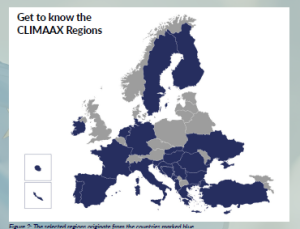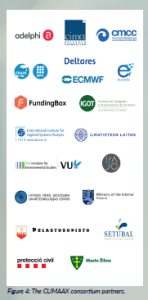CLIMAAX is one of the flagship projects of the EU Mission on Adaptation to Climate Change. It provides financial, analytical and practical support to improve regional climate and emergency risk management plans. Herewith, it contributes to the EU Adaptation Strategy by preparing and planning for regional climate resilience. The project is now halfway through, making it a good time to share what has been achieved and its first lessons learned.
Standardised flexibility
Unfortunately, many European regions and communities lack the necessary experience and resources to effectively integrate available local and global data, models, and concepts into context-specific climate risk assessments (CRAs). CLIMAAX is designed to contribute to the harmonisation and consolidation of the practice of CRA, aiming to leave a legacy for upcoming European initiatives. The CLIMAAX tools serve a variety of regions, each with its own unique needs, interests and climate vulnerabilities.
CRA framework
The CLIMAAX methodological framework is designed to encompass and support inclusive and harmonised regional CRAs. The framework translates the ambitions of the EU Mission on Adaptation into practice. This EU mission unites European regions on their pathway to resilience and the ability to cope with climate extremes by implementing transformational adaptation and emergency management strategies. This is supported by the European Environment Agency, which has developed the Regional Adaptation Support Tool (RAST), providing practical guidance for planning, implementing and evaluating climate adaptation strategies.
An online version of the CLIMAAX framework with a detailed step-by-step explanation and guiding questions is provided in the CLIMAAX CRA Handbook. The framework was designed to:
- enhance practical implementation from the latest scientific developments
- support improved coherence across countries and regions based on generally accepted, standardised approaches as part of a shared, inclusive and harmonised framework
- avoid too many layers of complexity so as not to discourage regions and stakeholders
- allow for flexibility and scalability in implementation for learning, increasing complexity and comprehensive treatment of climate risk.
CRA Toolbox
The CLIMAAX CRA Toolbox includes data, projections and risk assessment algorithms (contained in so-called ‘risk workflows’) designed to support the compilation of regional CRAs. Risk assessment workflows are included based on the type of hazard. Currently, the toolbox contains methods for flood, drought, heatwave, wildfire, windstorm and snow. The different assessment methods follow a stepwise data processing scheme to calculate risk as a combination of hazard, exposure and vulnerability.
The CLIMAAX toolbox links to the Copernicus Climate Data Store and includes datasets of pan-European hazard, exposure and vulnerability data for implementing various risk assessment methods. These European datasets include reference hazard climatologies and basic climate change scenarios, as well as data on exposure and vulnerability, such as land use, building types, age, education, income, healthcare access, settlements and infrastructure. In some workflows, multiple customised datasets and future scenarios of exposure and vulnerability are already made available. The toolbox allows users to customise their risk assessment and to upload their data. In the expert level version of the toolbox, customised risk assessment procedures can be implemented.
Co-development
In the first 18 months, the framework and workflows were co-developed and optimised in close collaboration with representatives from five European pilot regions (Catalonia, Finland, Latvia, and the cities of Setúbal and Žilina). They helped set out the requirements and tested the applicability of the workflows for assessing their local/ regional climate risk.
The first operational version of the CLIMAAX Handbook included both the Framework and Toolbox. It was launched when the project was only 18 months underway. The handbook and individual workflows are regularly improved based on the feedback from the regions and other users. In this way, it can better be ensured that the developed services and tools align with the local needs.
Cascading fund for regional CRA
For the European Commission, the CLIMAAX project provides a means to distribute funding to regional and local authorities for conducting their own. Part of the CLIMAAX project is a cascading fund of approximately 12 million Euros. This is used to finance carefully selected European regions to conduct their own CRA project, building upon CLIMAAX tools and guidance.
The consortium hosted two open calls for third-party projects. There was a huge interest in participation. In total, 382 applications were submitted. From these applications, 69 regions (see Figure 2—the countries marked blue) were selected for funding.
Support functions
Meanwhile, they have all started their work, and for support, they can rely on the consortium. There is a helpdesk, webinars and weekly drop-in sessions. An open community of practice (CoP) has been set up to enable interaction between the regions and beyond. The aim of the CoP is to facilitate exchange and learning. At the national level, peer groups of regions have already started to collaborate and exchange experiences. A first live meeting for all regions was organised in June in Barcelona.
Lessons learned: success factors so far
The technical assistance provided by the CLIMAAX project and MIP4ADAPT is crucial to making the CRAs a success. Some regions have ample experience and have conducted earlier CRAs or related assessments themselves; for others, this work is still relatively new. Therefore, access to support and training is key.
There is a gap between the local/ regional needs and the currently existing European climate services landscape. This is especially the case when potential adaptation measures are to be validated or when local hazards, such as flash floods, are considered. The workflows are designed to partially bridge this gap and enable the integration of local data. Additionally, regions can allocate one year of their sub-project to enhance the assessment using European tools, local models, and data.
The CLIMAAX tools provide more than a regular data viewer. The Jupyter Notebook-based risk workflows enable greater flexibility and local refinement. Although the Jupyter Notebook structure is often perceived as complex, the first set of CRA reports from the CLIMAAX regions included hazard and/ or risk indicators for at least one type of hazard.
There is positive feedback from the CLIMAAX regions:
- The EU data-based assessments provide them with a benchmark of their own work, resulting in leverage when negotiating with local governments.
- Regions recognise that CLIMAAX really attempts to tackle the challenges of applying science-based methodologies in a real-world context.
Finally, a key factor contributing to the success is CRA ownership. The regions receive the funding and are thus responsible for the execution of their CRA. They are allowed to subcontract local technical experts through their national procurement procedures. All of this contributes to the development of climate-responsible regions.
The next challenge lies in ensuring that the CRA data lead to meaningful actions and improvements on the ground—actions that help make the regions more climate resilient. Therefore, in the second and third phases of the projects, there will be a greater emphasis on stakeholder engagement and the potential implications of the CRA outcomes for local climate adaptation and disaster risk management.
Together with the Mission on Adaptation and the regions, the CLIMAAX consortium aims to build a more resilient future, ensuring that Europe is better equipped, more adaptable and prepared to thrive in a changing climate.
Project summary
CLIMAAX is the flagship project of the EU Mission on Adaptation to Climate Change, providing financial, analytical and practical support to enhance regional climate and emergency risk management plans. In the first two years, a toolbox and framework were implemented for coherent science-based climate risk assessment (CRA). These are now applied by 69 European regions to improve their CRA.
Project partners
Deltares, UPC, CIMA, FMI, EURADA, ADELPHI, IIASA, FBA, VU-IVM, CMCC, ECMWF KAJO, IGOT, INTC, Zilina, Setúbal, MoIFI, LVGMC, and ESAF.
Project lead profile
Dr Frederiek Sperna Weiland holds an MSc in hydrology from Wageningen University and a PhD in hydrology and climate change from Utrecht University. She has been working at the Dutch knowledge institute Deltares for nearly 20 years. She has been involved in EU Framework projects related to the value of EO and climate datasets for water resources and climate impact studies.
Project contacts
info@climaax.eu climaax.eu handbook.climaax.eu CLIMAAX
Funding disclaimer
This project has been funded by the European Union’s Horizon Europe research and innovation programme – grant agreement number 101093864.
Views and opinions expressed are however those of the author(s) only and do not necessarily reflect those of the European Union. Neither the European Union nor the granting authority can be held responsible for them.
Figure legends
Figure 1: The CLIMAAX framework.
Figure 2: The selected regions originate from the countries marked blue.
Figure 3: The first regions meeting in Barcelona – June 2025.
Figure 4: The CLIMAAX consortium partners.





